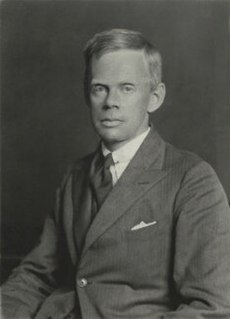
Sir John Robert Vane was a British pharmacologist who was instrumental in the understanding of how aspirin produces pain-relief and anti-inflammatory effects and his work led to new treatments for heart and blood vessel disease and introduction of ACE inhibitors. He was awarded the Nobel Prize in Physiology or Medicine in 1982 along with Sune Bergström and Bengt Samuelsson for "their discoveries concerning prostaglandins and related biologically active substances".

Frederick Sydney Dainton, Baron Dainton, Kt, FRS, FRSE was a British academic chemist and university administrator.

Andrew David Hamilton is a British American chemist and academic who is the 16th and current President of New York University. From 2009 to 2015, he served as the Vice-Chancellor of the University of Oxford. Before leading Oxford, he was Provost of Yale University from 2004 to 2008.

Sir Cyril Norman Hinshelwood was a British physical chemist and expert in chemical kinetics. His work in reaction mechanisms earned the 1956 Nobel Prize in chemistry.

Jack Lewis, Baron Lewis of Newnham, FRS, HonFRSC was an English chemist working mainly in the area of inorganic chemistry.

Jonathan A. Jones is a professor in atomic and laser physics at the University of Oxford, and a fellow and tutor in physics at Brasenose College, Oxford.

Keith Anderson Hope Murray, Baron Murray of Newhaven, KCB was a British academic and Rector of Lincoln College, Oxford.
Sir Hrothgar John Habakkuk was a British economic historian.

Charles Wayne Rees CBE FRS FRSC was a British organic chemist.

Sir David Charles Clary, FRS is a British theoretical chemist. He was president of Magdalen College, Oxford, from 2005 to 2020. He was the first chief scientific adviser to the Foreign and Commonwealth Office from 2009 to 2013. He is a Professor of Chemistry at the University of Oxford.

Professor Anthony John Grenville Hey was Vice-President of Microsoft Research Connections, a division of Microsoft Research, until his departure in 2014.

Martin Fleischmann FRS was a British chemist who worked in electrochemistry. Premature announcement of his cold fusion research with Stanley Pons, regarding excess heat in heavy water, caused a media sensation and elicited skepticism and criticism from many in the scientific community.

(William) Graham Richards is a chemist and Emeritus Fellow of Brasenose College, Oxford. He served as head of the department of chemistry at the University of Oxford from 1997 to 2006.

Laurence David Barron has been Gardiner Professor of Chemistry at the University of Glasgow since 1998. He is a chemist who has conducted pioneering research into the properties of chiral molecules — defined by Lord Kelvin as those that cannot be superimposed onto their mirror image. By extending this definition of chirality to include moving particles and processes that vary with time, he has made a fundamental theoretical contribution to the field. Chiral molecules such as amino acids, sugars, proteins, and nucleic acids play a central role in the chemistry of life, and many drug molecules are chiral. Laurence’s work on Raman optical activity — a spectroscopic technique capable of determining the three-dimensional structures of chiral molecules, which he predicted, observed, and applied to problems at the forefront of chemistry and structural biology — has led to its development as a powerful analytical tool used in academic and industrial laboratories worldwide. His much-cited book, Molecular Light Scattering and Optical Activity, has contributed to the growing impact of chirality on many areas of modern science.

Sir John Shipley Rowlinson was a British chemist. He attended Oxford University, where he completed his undergraduate studies in 1948 and doctoral in 1950. He then became research associate at University of Wisconsin (1950–1951), lecturer at University of Manchester (1951–1961), Professor at Imperial College London (1961–1973) and back at Oxford from 1974 to his retirement in 1993.

Alan Carrington CBE, FRS was a British chemist and one of the leading spectroscopists in Britain in the late twentieth century.

Neil Kensington Adam was a British chemist.

David Phillips, is a British Chemist specialising in photochemistry and lasers, and was president of the Royal Society of Chemistry from 2010 to 2012.
Sir Charles Richard Arthur Catlow is a British chemist and professor at University College London and Cardiff University. Previously, he was Director of the Davy-Faraday Research Laboratory (1998–2007), and Wolfson Professor of Natural Philosophy at the Royal Institution. Since 2016, he has served as the foreign secretary of the Royal Society., and since 2021 as President of the InterAcademy Partnership (IAP).
Sir Harry Work Melville, was a British chemist, academic, and academic administrator, who specialised in polymer research. He spent his early career in academia as a lecturer and researcher, before moving into administration as a civil servant and university college head.

















